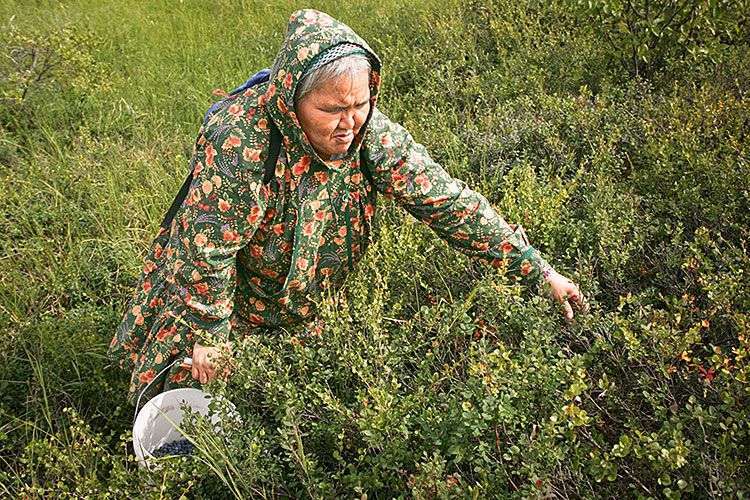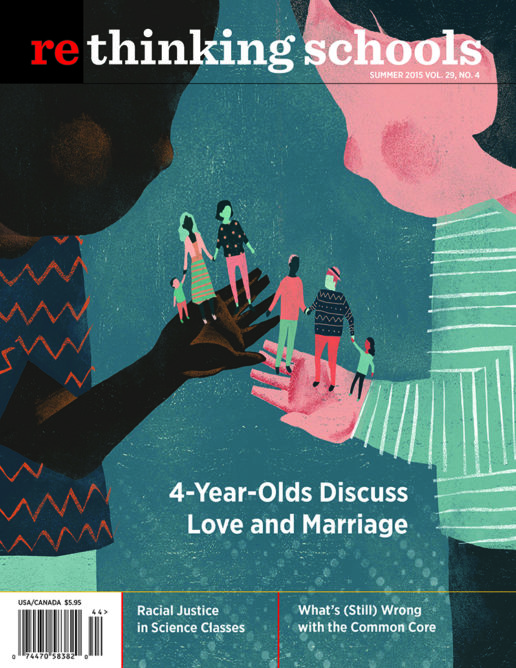Climate Change and School in a Yup’ik Fishing Village

Photo credit: Clark James Mishler
I teach 6th grade in a small Yup’ik fishing village in southwestern Alaska. Alaska and other arctic regions are at the forefront of experiencing climate change. “The arctic is warming at twice the rate of anywhere else on Earth,” according to the National Oceanic and Atmospheric Administration’s Arctic Report Card. As the climate changes, the traditional ways of subsistence are threatened. Climate change is having a real and direct impact on this community now, yet the school and curriculum continue to be almost completely silent on the issue—and so much else that matters in my students’ lives.
My family moved to rural Alaska from Portland, Oregon, driven by a love for adventure, a need for employment, and a desire to make a positive impact. Arriving in 2013, we experienced one of the mildest winters in this Alaska region’s history. Dust built up on snowmobiles (we call them snow-goes) instead of snow. In desperation, some villagers began taking their snow-goes across the snowless tundra. Time and again, elders talked about how they had never seen weather like this.
In 2014, I arrived back in the village after summer break, and a beloved teacher and local resident greeted me with heart-sickening news: “There are no berries this year.” The tundra has to freeze for a certain length of time and to a certain depth for the tundra blackberries and salmonberries to regenerate. The practice of harvesting and preserving berries goes back hundreds of years, and all of my students talk about their experiences picking berries with their mothers or grandmothers. These days the berries are used in making the ever-popular akutaq (pronounced uh-GOO-dic) ice cream. In several “I Am From” poems, students included the line “I am from akutaq,” stressing the importance of berries to their personal identities.
Our principal is a Yup’ik elder who left his village to get his education and returned to work in the school. He cares deeply about the students and community. I asked about the condition of the permafrost in the area. He didn’t know if there was any permafrost left. He told me that the next time someone dies I could go down to the cemetery and check where the excavator digs the hole to see if it hits frozen ground. He didn’t think it would. He said that Yup’ik people used to dig deep holes to store food, creating a freezer in the ground. We didn’t talk about the fact that permafrost holds vast amounts of carbon frozen in the ground. As the permafrost disappears, tons of carbon are released into the atmosphere, an example of the frightening “feedback loops” that will accelerate climate change as the planet warms.
My student teacher, also a local resident, told me that when she was young the bay was frozen every winter by mid-October. In mid-December this year, I only needed a light jacket to take the four-wheeler into town. There was no ice in the bay, no snow on the ground. As I waited for our bush plane, an Indigenous woman said to me, “You must love this warm weather.” How could I tell her that I lie awake at night and worry that this climate chaos will bring unthinkable violence and loss? Instead I chose: “This weather makes me nervous because humans are messing with nature in ways we don’t even understand.”
One day last fall, I received a text from my mom about a big storm heading toward Alaska. She said it was national news. I was browsing the weather pages online when my students came in from lunch. They were curious what I was looking at, so we talked about the storm (it was not heading our way, but toward the Aleutians). I asked the students if they knew the village plan in case a big storm or typhoon came our way. Most of the village is built near the shore and likely will face the need to relocate in the years to come as sea levels rise.
“You know,” one student said, “during the last big storm, the waves crashed into the seawall and a left big crack, right near Jen’s house!”
I followed up this classroom discussion with a phone call to the environmental program coordinator for the village. He told me that the region has seen much stronger storm surges in recent history, and he attributes them to climate change.
I asked students if they knew that the overall temperature of the Earth was warming and that the arctic ice was melting.
“What are you talking about?” they demanded.
I took out the globe and showed them the arctic region and demonstrated how the ice was shrinking. I explained that melted ice expands.
“Why is this happening?” a student asked.
I reminded them what carbon dioxide is and explained that there’s too much carbon dioxide in the atmosphere so it’s acting like a blanket trapping the sun’s heat.
“Well, why is that happening?”
I gave the briefest possible explanation of greenhouse gas pollution and the unbalancing of the carbon cycle (one that would probably make most scientists cringe), and promised my students that we would return to this discussion. I knew these short conversations about climate change were insufficient, so we’ve begun an in-depth climate change study this spring that focuses on the science of the carbon cycle, the impact of humans on climate change, and the impact of climate change on humans, especially those of us in Alaska.
A Yup’ik Community Struggling to Keep Its Culture Alive
Alaskan Native cultures, similar to Indigenous people around the world, have survived repeated cultural assaults from colonization, but this survival has come at a high cost. In my village and in rural villages throughout Alaska, alcoholism, depression, suicide, and drug abuse are rampant. After reading Harold Napoleon’s Yuuyaraq: The Way of the Human Being, I’m beginning to understand. It’s not that Indigenous people have weak characters or are genetically flawed but, as Napoleon explains, after the waves of violence and disease that colonization brought to village after village, the survivors were left with epidemic levels of post-traumatic stress disorder. One can only imagine the emotional and spiritual impact of watching entire villages die. At the same time, Christianity was imposed, telling people that they could not practice their dances or listen to their shamans. When people needed their cultural practices the most, they were being taken away from them.
Climate change is the next and perhaps the largest assault on Alaskan Indigenous culture. It’s forcing the loss of communities’ abilities to practice centuries-old subsistence living. For example, one of our school custodians has always ventured up into the mountains to hunt moose over the winter break. This year he had to stay home because it was too muddy. When we talked about our breaks, he described his deep disappointment to me—for the loss of food for the winter, and the connection to his family’s past.
We don’t talk about climate change, and we definitely don’t talk about the bigger picture: the loss of culture and the accompanying pain and grief that so many people must be experiencing. Instead, we talk about the “crazy weather.” I wonder if therapists will need a new term, traumatic climate stress disorder, because we are living through powerful losses now. I also wonder about the mental health effects on this generation of children and their children unless we start to communicate, heal, and involve them in the fight to keep carbon in the ground.
A Yup’ik School Without a Climate Conversation
In our 6th-grade U.S. history text, climate change is not mentioned once. In fact, Alaska is not mentioned once. In our science text, climate change is given a cursory paragraph that includes no discussion of the large-scale social and environmental upheavals at stake.
Earlier this year, a district administrator forwarded us a local news link about climate change. We were encouraged to use the article with our students. The article explained that salmon runs would likely be up this year because of the warmer water temperatures in Bristol Bay—a real economic boom for the region. This article and our district administrator both failed to mention the relationships among carbon, ocean acidification, and loss of salmon; instead, it was a “happy” story. They focused on short-term economic benefits.
Given the climate emergency and the threat that it will exacerbate what is already a cultural crisis, one would hope that this would be a main topic among educators here. But it isn’t. Our staff meetings and school improvement team meetings have been centered on two topics this year. First, we started the year discussing how we can improve our ASPI (Alaska School Performance Index) score—we are a low-ranked “one-star” school once again. We talked about how to raise our test scores and attendance. Proposals included rewards to students for coming to school and administrators volunteering to shave their heads.
Second, we’ve spent the last several staff meetings getting “amped up” for the Alaska Measure of Progress (AMP) Standardized Testing, Alaska’s version of the Common Core tests. This year, administrators informed the staff that testing will take the entire month of April. In years past, the school celebrated the end of testing with a weeklong cultural camp—elders came and shared stories, crafts, language, subsistence skills, and history. This year the camp has been postponed indefinitely because of the longer time needed for testing.
At our staff meetings, we don’t ask how we can make our classes relevant and meaningful for Alaskan Native students. We don’t talk about making curriculum meaningful so students want to come to school—and when I say meaningful I mean not just about climate change, but also about such issues as poverty and privilege, racism, cultural and linguistic survival, and mental health.
We don’t talk about the trauma our students face and how our school can help them.
And never once have we taken the conversation further than “Wow, this is crazy weather we’re having!” Never once have we talked about teaching the climate emergency. It’s as if our collective house is filling with water and we’re spending our time polishing the silverware.
I’m a newcomer to this school and to this village. I’ve been hesitant to make waves, to “push an agenda” at staff meetings. But I’ve seen how standardized testing and the ranking of schools and teachers stifles conversation about anything that truly mattersÑeven when those issues threaten to change people’s lives forever.
My response up to now has been avoidance: I close my door and try to create authentic and meaningful classroom experiences for my students. But the Bristol Bay region—and the world—is in a climate emergency. So this is my “declaration of independence,” my commitment to do what I can to make that emergency and the cultural crisis the center of our conversations about teaching.

